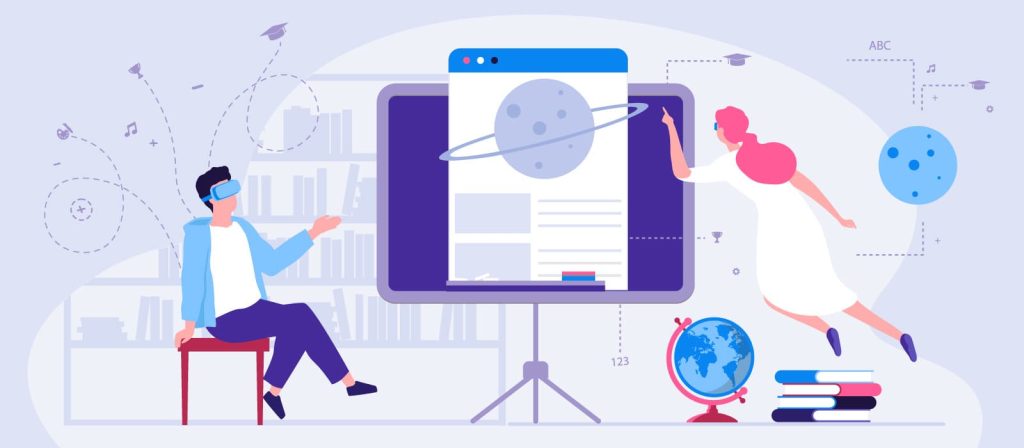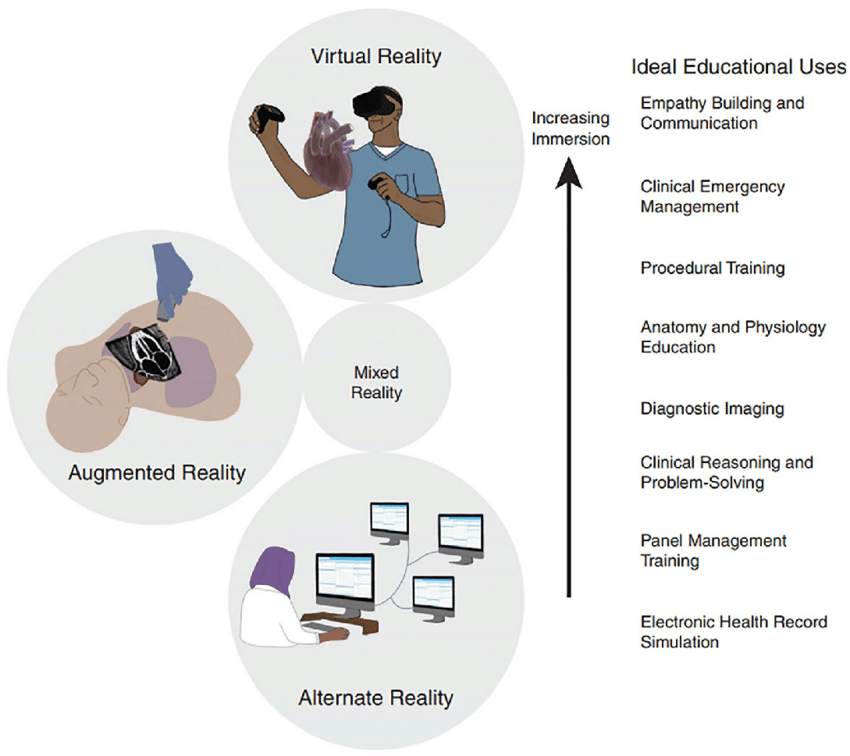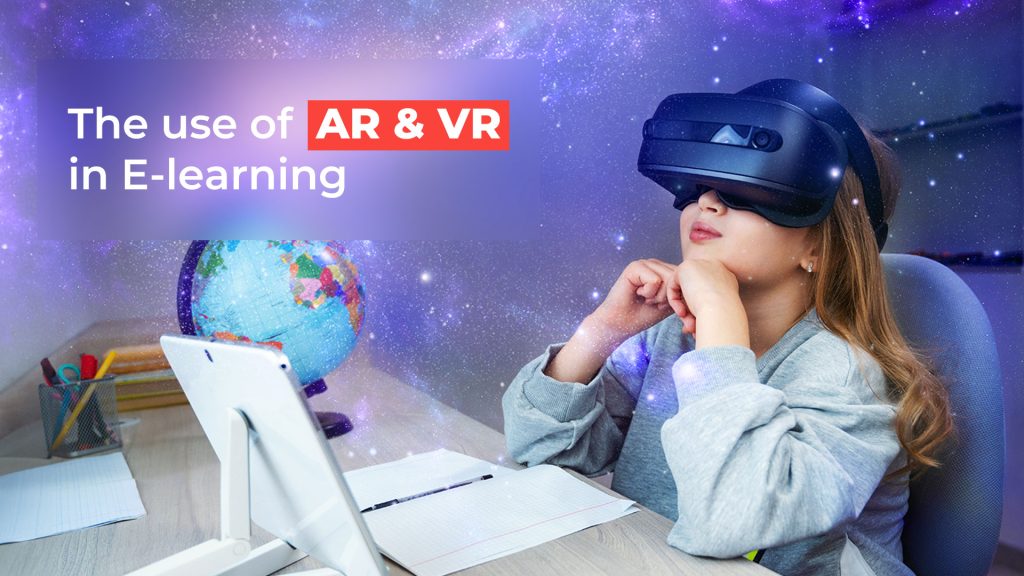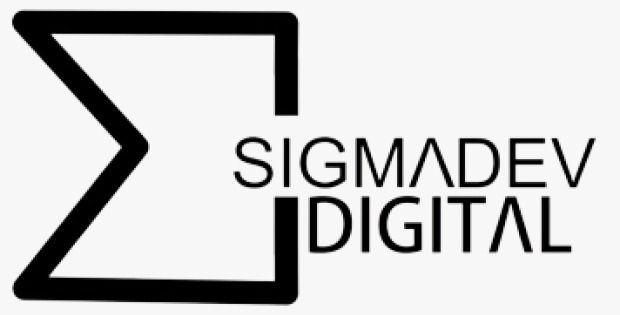Table of Contents

In recent years, the advent of advanced technologies such as Virtual Reality (VR) and Augmented Reality (AR) has revolutionized various fields, including training and education. These immersive technologies offer new ways to engage learners, enhance understanding, and provide hands-on experience in a controlled, safe environment. This article delves into the comparative uses of VR and AR in training and education, exploring their unique advantages, applications, and future potential.
INTRODUCTION TO VIRTUAL REALITY AND AUGMENTED REALITY
VIRTUAL REALITY (VR)
Virtual Reality is a fully immersive technology that creates a simulated environment, which users can interact with in a seemingly real or physical way using special electronic equipment, such as headsets with screens and sensors. VR completely replaces the user’s real-world surroundings with a virtual environment, providing an engaging and interactive experience.
AUGMENTED REALITY (AR)
Augmented Reality, on the other hand, overlays digital information—such as images, videos, or sounds—onto the real world through devices like smartphones, tablets, or AR glasses. Unlike VR, AR enhances the user’s perception of the real world by adding virtual elements, thereby maintaining the connection with the physical environment.
THE ROLE OF VR AND AR IN EDUCATION AND TRAINING
Both VR and AR have found extensive applications in education and training, thanks to their ability to provide immersive and interactive learning experiences. Let’s explore how each technology contributes to these fields.
VIRTUAL REALITY IN EDUCATION AND TRAINING
- ENHANCING ENGAGEMENT AND MOTIVATION
One of the most significant advantages of VR in education is its ability to captivate students’ attention and keep them engaged. Traditional teaching methods often struggle to maintain student interest, but VR’s immersive nature makes learning more exciting and enjoyable. For instance, history lessons can be transformed into virtual tours of ancient civilizations, allowing students to experience historical events and locations firsthand.
- FACILITATING EXPERIENTIAL LEARNING
VR enables experiential learning by allowing students to practice and apply theoretical knowledge in a simulated environment. This is particularly beneficial in fields like medicine, engineering, and aviation, where hands-on experience is crucial. Medical students can perform virtual surgeries, engineering students can build and test structures, and aspiring pilots can undergo flight simulations—all without the risks associated with real-life practice.
- OVERCOMING GEOGRAPHICAL BARRIERS
VR breaks down geographical barriers, making education more accessible to students regardless of their location. Virtual classrooms enable students from different parts of the world to attend lectures and collaborate on projects, fostering a global learning community. This is especially valuable for students in remote or underserved areas who may not have access to quality education.
- PERSONALIZED LEARNING EXPERIENCES
VR can provide personalized learning experiences tailored to individual students’ needs and learning styles. Adaptive VR systems can analyze student performance and adjust the difficulty level or type of content accordingly. This personalized approach helps ensure that each student receives the support and challenges they need to succeed.
- SAFE ENVIRONMENT FOR RISKY TRAINING
In fields where training involves significant risks, such as firefighting, military operations, or hazardous material handling, VR offers a safe and controlled environment for practice. Trainees can experience realistic scenarios and develop critical skills without exposure to actual danger. For example, firefighters can practice navigating burning buildings, and soldiers can engage in combat simulations.
AUGMENTED REALITY IN EDUCATION AND TRAINING
- ENHANCING LEARNING WITH INTERACTIVE CONTENT
AR enriches traditional learning materials by adding interactive elements that make lessons more engaging and informative. Textbooks can come to life with 3D models, animations, and videos that provide additional context and explanations. For example, biology students can use AR apps to visualize the human body’s anatomy, exploring organs and systems in detail.
- BRIDGING THE GAP BETWEEN THEORY AND PRACTICE
AR bridges the gap between theoretical knowledge and practical application by overlaying digital instructions and guides onto real-world objects. In technical training, such as automotive repair or equipment maintenance, trainees can use AR glasses to receive stepby-step instructions superimposed on the machinery they are working on. This hands-on guidance enhances understanding and proficiency.
- SUPPORTING COLLABORATIVE LEARNING
AR facilitates collaborative learning by allowing students to interact with digital content and each other in shared physical spaces. In collaborative projects, students can use AR to visualize and manipulate 3D models, annotate them, and discuss their ideas in real time. This promotes teamwork, communication, and problem-solving skills.
- IMPROVING ACCESSIBILITY AND INCLUSIVITY
AR can improve accessibility for students with disabilities by providing alternative ways to interact with learning materials. For example, AR applications can offer real-time subtitles for students with hearing impairments or visual aids for those with visual impairments. This ensures that all students have equal opportunities to participate and learn.
- ENHANCING FIELD TRIPS AND REAL-WORLD LEARNING
AR enhances field trips and real-world learning experiences by adding layers of information to physical locations. Students can use AR apps to access historical facts, scientific data, or cultural insights while visiting museums, historical sites, or nature reserves. This contextual information enriches their understanding and makes learning more immersive.
COMPARATIVE ANALYSIS OF VR AND AR IN TRAINING AND EDUCATION
IMMERSION AND ENGAGEMENT
VR offers a higher level of immersion compared to AR, as it completely envelops users in a virtual environment. This full immersion can significantly enhance engagement and motivation, making VR an excellent tool for scenarios that require deep focus and involvement. AR, while less immersive, still provides engaging experiences by enhancing the real world with interactive digital content.
PRACTICAL APPLICATION AND ACCESSIBILITY
AR has an edge in terms of practical application and accessibility. Since AR overlays digital information onto the real world, it can be used with common devices like smartphones and tablets, making it more accessible to a broader audience. VR, on the other hand, often requires specialized equipment, which can be a barrier for widespread adoption.
FLEXIBILITY AND VERSATILITY
Both VR and AR offer flexibility and versatility, but in different ways. VR excels in creating entirely new environments and scenarios, making it ideal for simulations and experiential learning. AR, however, shines in augmenting the real world with additional information and interactive elements, making it suitable for enhancing traditional learning materials and providing real-time guidance.
COST AND IMPLEMENTATION
The cost of implementing VR and AR can vary significantly. VR typically involves higher upfront costs due to the need for specialized hardware, such as VR headsets and motion sensors. AR can be more cost-effective, especially when used with existing devices like smartphones. However, developing high-quality AR and VR content can still be expensive, requiring skilled developers and designers.
USER EXPERIENCE AND COMFORT
User experience and comfort are crucial considerations when choosing between VR and AR. VR can cause motion sickness and discomfort for some users, especially during prolonged use. AR generally offers a more comfortable experience, as it does not isolate users from their physical surroundings. This makes AR more suitable for extended use in educational settings.

CASE STUDIES: VR AND AR IN ACTION
VIRTUAL REALITY CASE STUDY: MEDICAL TRAINING
Medical training is one of the most prominent fields where VR has made a significant impact. Traditional medical training involves extensive theoretical study and limited practical experience due to the risks associated with real-life practice. VR addresses this challenge by providing realistic simulations for medical students and professionals.
EXAMPLE: VIRTUAL SURGERY SIMULATIONS
One notable example is the use of VR for virtual surgery simulations. Companies like Osso VR and Touch Surgery have developed VR platforms that allow medical students and surgeons to practice complex surgical procedures in a risk-free environment. These simulations provide realistic feedback, helping trainees develop their skills and confidence before performing surgeries on real patients.
THE BENEFITS OF VR IN MEDICAL TRAINING INCLUDE:
HANDS-ON PRACTICE: Trainees can practice surgeries repeatedly, honing their skills and reducing the likelihood of errors in real-life procedures.
REALISTIC SCENARIOS: VR simulations can replicate various surgical scenarios, including rare and complex cases, providing comprehensive training.
IMMEDIATE FEEDBACK: VR systems offer immediate feedback on performance, allowing trainees to learn from their mistakes and improve continuously.
AUGMENTED REALITY CASE STUDY: TECHNICAL TRAINING
Technical training, such as automotive repair and equipment maintenance, has greatly benefited from AR’s ability to overlay digital information onto real-world objects. AR provides real-time guidance and instructions, enhancing trainees’ understanding and proficiency.
EXAMPLE: AR-ASSISTED AUTOMOTIVE REPAIR
A notable example is the use of AR in automotive repair. Companies like Bosch and PTC have developed AR applications that provide technicians with step-by-step instructions and 3D models superimposed on the vehicle they are working on. Technicians can see detailed instructions on how to disassemble and reassemble parts, diagnose issues, and perform repairs.
THE BENEFITS OF AR IN TECHNICAL TRAINING INCLUDE:
HANDS-ON GUIDANCE: Trainees receive real-time, hands-on guidance, reducing the learning curve and increasing efficiency.
ERROR REDUCTION: AR minimizes the risk of errors by providing clear, visual instructions, ensuring that tasks are performed correctly.
ENHANCED UNDERSTANDING: AR allows trainees to visualize complex systems and components, improving their understanding of how things work.
FUTURE POTENTIAL AND CHALLENGES
FUTURE POTENTIAL OF VR IN EDUCATION AND TRAINING
The future potential of VR in education and training is vast. As technology advances, VR experiences will become more realistic and immersive, further enhancing learning outcomes. Some potential future developments include:
ADVANCED HAPTICS: Improved haptic feedback technology will allow users to feel textures and sensations in VR, making simulations even more lifelike.
AI INTEGRATION: Artificial intelligence can personalize VR experiences, adapting content and difficulty levels to individual learners’ needs.
REMOTE COLLABORATION: Enhanced VR collaboration tools will enable students and professionals to work together in virtual environments, regardless of their physical locations.
FUTURE POTENTIAL OF AR IN EDUCATION AND TRAINING
AR also holds immense potential for the future of education and training. As AR technology becomes more sophisticated, its applications will expand, providing even more interactive and informative experiences. Some potential future developments include:
WEARABLE AR DEVICES: AR glasses and contact lenses will become more mainstream, providing seamless, hands-free access to augmented information. These devices will enable learners to interact with digital content without the need for handheld devices.
CONTEXT-AWARE AR: AR systems will become more context-aware, providing relevant information based on the user’s location, activity, and real-time needs. This could revolutionize fields like medical diagnostics, fieldwork, and maintenance.
EDUCATIONAL AR APPS: More sophisticated AR educational apps will be developed, catering to a wide range of subjects and educational levels. These apps will offer interactive learning experiences that can adapt to different learning styles and preferences.
CHALLENGES AND CONSIDERATIONS
Despite their promising potential, VR and AR in education and training face several challenges that need to be addressed for widespread adoption.
- COST AND ACCESSIBILITY
The cost of developing and implementing VR and AR solutions can be prohibitive, especially for educational institutions with limited budgets. High-quality VR systems require expensive hardware, and developing custom VR and AR content can be resource intensive. Ensuring that these technologies are accessible to all students, regardless of their socio-economic status, is a critical challenge.
- TECHNICAL LIMITATIONS
While VR and AR technologies are rapidly advancing, they still have technical limitations that can impact the user experience. VR headsets can be bulky and uncomfortable for extended use, and motion sickness remains a concern for some users. AR relies heavily on the quality and capabilities of the device’s camera and sensors, which can vary widely between different devices.
- CONTENT DEVELOPMENT
Creating effective and engaging VR and AR content requires specialized skills and expertise. Educational content must be pedagogically sound, interactive, and immersive, which can be challenging to achieve. Additionally, ensuring that content is regularly updated and aligned with the latest curriculum standards is essential for its long-term relevance and effectiveness.
- INTEGRATION WITH EXISTING SYSTEMS
Integrating VR and AR into existing educational and training systems can be complex. Institutions need to ensure that these technologies complement traditional teaching methods rather than replace them. Effective integration requires training for educators, compatibility with current infrastructure, and alignment with educational goals and standards.
- PRIVACY AND SECURITY
The use of VR and AR in education raises concerns about privacy and data security. These technologies often collect and process personal data, such as user interactions and performance metrics. Ensuring that this data is securely stored and used ethically is crucial to protect students’ privacy and comply with regulations.
PERSONALIZED LEARNING AND ADAPTIVE FEEDBACK
One of the most promising aspects of VR and AR in education is the ability to offer personalized learning experiences. These technologies can adapt to the individual needs, learning pace, and styles of students, providing customized content and feedback.

VR AND PERSONALIZED LEARNING
ADAPTIVE LEARNING PATHS: VR can track a student’s progress and adjust the difficulty level or the type of content presented. For example, a VR-based language learning app could adjust vocabulary and grammar exercises based on the user’s proficiency level.
IMMERSIVE ASSESSMENT: In VR environments, educators can conduct assessments in a more interactive and engaging manner. Instead of traditional tests, students might navigate through a virtual scenario where they demonstrate their knowledge and skills.
FEEDBACK AND ANALYTICS: VR systems can provide immediate feedback and detailed analytics on student performance. Educators can use this data to identify areas where students struggle and provide targeted support.
AR AND PERSONALIZED LEARNING
REAL-TIME ASSISTANCE: AR can offer real-time assistance tailored to individual learners. For instance, a math AR app could provide step-by-step guidance based on where the student is having difficulty.
INTERACTIVE STUDY AIDS: AR can enhance traditional study materials with personalized interactive elements. Students can scan textbook pages with their devices to access additional resources like videos, quizzes, and 3D models that match their learning needs.
PERFORMANCE TRACKING: Like VR, AR can also track student performance and adapt content accordingly. This continuous assessment can help in maintaining a personalized learning curve for each student.
GAMIFICATION AND INTERACTIVE LEARNING
Gamification involves incorporating game elements into non-game contexts, and both VR and AR are well-suited for this approach. Gamification can significantly enhance motivation, engagement, and retention in educational settings.
GAMIFICATION WITH VR
VIRTUAL QUESTS AND CHALLENGES: VR can transform lessons into immersive quests where students must complete challenges to progress. For example, history lessons can be turned into time-travel adventures where students solve historical mysteries.
SIMULATION-BASED GAMES: In subjects like physics or chemistry, VR can simulate experiments and scenarios where students learn by doing. These simulations can be gamified with rewards and progression systems.
SOCIAL LEARNING: VR platforms can create multiplayer environments where students collaborate and compete in educational games. This social interaction can foster teamwork and communication skills.
GAMIFICATION WITH AR
INTERACTIVE AUGMENTED GAMES: AR can bring traditional learning materials to life through games. For example, an AR app for biology might allow students to explore a cell by navigating through an augmented reality game.
SCAVENGER HUNTS: AR can be used to create educational scavenger hunts where students search for information or solve puzzles in their physical environment. This makes learning interactive and fun.
AUGMENTED FLASHCARDS: AR flashcards can make studying more engaging by adding 3D animations, sounds, and interactive quizzes. This approach can be particularly effective for younger learners.
ENHANCING SPECIAL EDUCATION
VR and AR offer significant potential to enhance special education by providing tailored support to students with diverse needs.
VR IN SPECIAL EDUCATION
THERAPEUTIC INTERVENTIONS: VR can be used for therapeutic purposes, such as helping students with autism practice social interactions in a controlled environment. Virtual environments can be designed to reduce sensory overload and provide calming experiences.
SKILL DEVELOPMENT: VR can help students with disabilities develop life skills. For example, a VR simulation might teach students how to navigate public transportation or handle everyday tasks.
ACCESSIBLE LEARNING: VR can create accessible learning experiences for students with physical disabilities by allowing them to explore environments and scenarios they might not be able to in real life.
AR IN SPECIAL EDUCATION
Visual and Auditory Support: AR can provide visual and auditory support to students with learning disabilities. For example, AR glasses can display text in a dyslexia-friendly font or provide real-time audio descriptions for students with visual impairments.
INTERACTIVE LEARNING AIDS: AR can turn everyday objects into interactive learning aids. For example, pointing an AR-enabled device at a book might trigger animations and sound effects that help explain the content.
BEHAVIORAL SUPPORT: AR can offer behavioral support tools, such as visual schedules and reminders, to help students with ADHD or autism stay organized and focused.
CORPORATE TRAINING AND PROFESSIONAL DEVELOPMENT
The applications of VR and AR extend beyond traditional educational settings into corporate training and professional development.
VR IN CORPORATE TRAINING
IMMERSIVE TRAINING PROGRAMS: VR can create realistic training scenarios for employees in various industries. For example, retail employees might use VR to practice customer service skills, or factory workers might train on machinery in a virtual environment.
REMOTE TRAINING: VR enables remote training programs, allowing employees to participate in training sessions from anywhere in the world. This is particularly useful for multinational companies with distributed teams.
COMPLIANCE AND SAFETY TRAINING: VR can simulate high-risk environments for compliance and safety training. Employees can practice emergency procedures and safety protocols in a controlled, risk-free setting.
AR IN CORPORATE TRAINING
ON-THE-JOB ASSISTANCE: AR can provide on-the-job assistance by overlaying instructions and information onto equipment. For example, an AR app might guide a technician through a complex repair process step-by-step.
KNOWLEDGE RETENTION: AR can enhance knowledge retention by making training materials interactive and engaging. For example, sales training might include AR scenarios where employees practice pitching products to virtual customers.
FIELD TRAINING: AR is particularly useful for field training in industries like construction, where trainees can receive real-time guidance and information while working on-site.
CULTURAL AND ETHICAL CONSIDERATIONS
As VR and AR become more prevalent in education and training, it’s essential to consider the cultural and ethical implications of these technologies.
CULTURAL SENSITIVITY
CONTENT RELEVANCE: Educational content in VR and AR should be culturally relevant and sensitive. Developers must consider diverse cultural perspectives and avoid content that might be biased or inappropriate for certain audiences.
INCLUSIVITY: Ensuring inclusivity is crucial. VR and AR experiences should be designed to accommodate learners from diverse cultural backgrounds, with options for different languages and cultural contexts.
ETHICAL CONCERNS
DATA PRIVACY: Protecting users’ data privacy is paramount. VR and AR applications often collect extensive data on user interactions, and it’s essential to handle this data responsibly and transparently.
MENTAL HEALTH: Prolonged use of VR can have implications for mental health, including potential addiction or desensitization to real-world experiences. It’s important to set guidelines for safe and healthy use.
CONTENT REGULATION: The immersive nature of VR and AR can make inappropriate or harmful content more impactful. There should be robust mechanisms for regulating and moderating content to protect users, especially younger learners.
THE FUTURE OF VR AND AR IN EDUCATION AND TRAINING

Looking ahead, the future of VR and AR in education and training is bright, with several emerging trends and innovations on the horizon.
MIXED REALITY (MR)
HYBRID LEARNING ENVIRONMENTS: Mixed Reality (MR), which combines elements of both VR and AR, offers exciting possibilities. MR can create hybrid learning environments where physical and virtual elements coexist seamlessly.
ENHANCED COLLABORATION: MR can facilitate more immersive and interactive collaborative learning experiences, enabling students and professionals to work together in mixed-reality spaces.
ARTIFICIAL INTELLIGENCE (AI) INTEGRATION
INTELLIGENT TUTORING SYSTEMS: AI-powered intelligent tutoring systems can be integrated with VR and AR to provide personalized guidance, adapt content in real-time, and offer predictive analytics on student performance.
VIRTUAL ASSISTANTS: Virtual assistants in VR and AR environments can provide real-time support, answer questions, and guide learners through complex tasks.
WEARABLE TECHNOLOGY
ADVANCED WEARABLES: The development of advanced wearable technology, such as AR contact lenses and more comfortable VR headsets, will enhance the user experience and make these technologies more practical for everyday use.
BIOMETRIC FEEDBACK: Wearable devices that track biometric data, such as heart rate and eye movement, can provide insights into student engagement and emotional responses, allowing for more adaptive learning experiences.
EXPANSION INTO NEW FIELDS
ARTS AND HUMANITIES: VR and AR are beginning to make inroads into the arts and humanities, offering immersive experiences for subjects like literature, history, and art appreciation. For example, students can explore virtual museums or participate in historical reenactments.
SOFT SKILLS TRAINING: These technologies can also be used to develop soft skills, such as communication, leadership, and teamwork, through role-playing scenarios and interactive simulations.
GLOBAL COLLABORATION AND KNOWLEDGE SHARING
GLOBAL CLASSROOMS: VR and AR can facilitate global collaboration and knowledge sharing, creating virtual classrooms where students from around the world can learn together and from each other. This can foster a more inclusive and interconnected educational environment.
CROSS-CULTURAL EXPERIENCES: These technologies can provide cross-cultural experiences, allowing students to virtually visit other countries, learn about different cultures, and develop a global perspective.
CONCLUSION
Virtual Reality and Augmented Reality are transforming the landscape of education and training, offering innovative ways to enhance learning experiences, improve engagement, and provide practical, hands-on training. While VR immerses users in entirely virtual environments, AR overlays digital information onto the real world, each bringing unique benefits to the table.
VR is particularly effective in scenarios that require full immersion and experiential learning, such as medical simulations, engineering training, and virtual field trips. Its ability to create realistic, risk-free environments makes it invaluable for developing practical skills and gaining experience.
AR, on the other hand, excels in enhancing real-world experiences with interactive digital content, making it ideal for technical training, collaborative learning, and accessibility. Its ability to provide real-time guidance and contextual information bridges the gap between theory and practice, making learning more relevant and engaging.
As these technologies continue to evolve, their potential in education and training will only grow. Advanced haptics, AI integration, wearable AR devices, and context-aware systems are just a few of the innovations on the horizon. However, addressing challenges such as cost, technical limitations, content development, integration, and privacy will be crucial for their widespread adoption and effectiveness.
In the future, the combination of VR and AR could create hybrid learning environments that leverage the strengths of both technologies. Imagine a classroom where students can seamlessly switch between virtual field trips, augmented textbooks, and real-world experiments, all tailored to their individual learning needs. This vision of the future holds the promise of a more immersive, interactive, and inclusive educational experience for learners of all ages and backgrounds.
Ultimately, the successful integration of VR and AR in education and training will depend on collaboration between educators, technologists, and policymakers. By working together, we can harness the power of these technologies to create a more engaging, effective, and equitable learning landscape for the generations to come.
